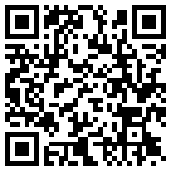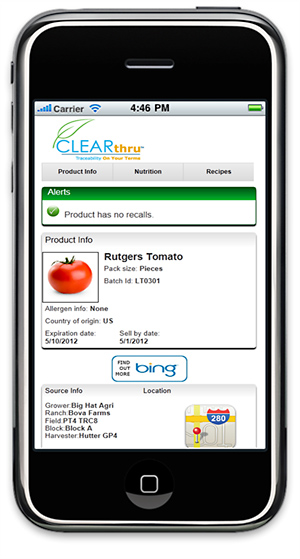Consumers who want farm-to-fork, supply chain information available to them on their smartphones while shopping at the grocery store may see this capability coming soon; some shoppers may already have a window to the supply chain. But such a system no doubt raises a few questions. Who pays for it? What supply chain members will want to participate, making their information public? What must processors do to make the system work? Who hosts the system?
One proprietary system, called CLEARthru, is an ERP-based solution that enables growers/shippers, producers, distributors, retailers and processors to move beyond traceability and offer consumers the ability to learn at the point of purchase the complete supply chain path their food takes on its way to the grocery store, from the plant or farm of origin to every processing or packing facility along the way.

|
| Christian Hutter. Source: Junction Solutions. |
The mobile application from Junction Solutions gives consumers access to information previously confined to an ERP system, such as origin of product, product freshness, packaging information, nutrition and allergen facts and food recall information. Consumers scan a “QR” coded label with their smartphones to get the information. The application is already being implemented by some of Junction Solutions’ food processor and distributor customers. FE asked Christian Hutter, senior vice president of food & beverage at Junction Solutions, for some details on how this system works.
FE: Does the consumer pay for the mobile app to use it at the grocery or produce store?
Christian Hutter: This is up to the food processor, food distributor or retailer. But in most cases, the consumer does not pay for this service. It is seen as a value benefit to the consumer, both from a source and safety perspective as well as a usage perspective. When paired with product use recommendations and coupons, it is a fast and simple way for the consumer to immediately and more fully leverage the merchandise while learning more about complementary products and saving money.
Junction Solutions is in talks with the US Food Safety organization to provide CLEARthru as the technology system for its multi-product alert notifications. In the proposed scenario, US Food Safety would create and maintain a database of alert and recall information for food and beverage products manufactured, distributed and sold in the US. The data would be housed and presented via the CLEARthru system. Consumers wanting to access real-time information from the US Food Safety system could download an app with a small monthly subscription fee of $.99 to $1.99 (price to be determined).

|
| Using their smartphones, consumers scan this QR code to obtain a supply chain history on the food products they're about to buy. Source: Junction Solutions. |
FE: Who decides what information to make available to the consumer, and whose ERP system will contain the information to be passed along?
Hutter: For unique manufacturers, distributors and retailers, it would be up to their discretion what products, merchandise, usage information and coupons would be included. It may be a single product channel or encompass their entire supply chain product portfolio. Since all information is pushed from an ERP system, any data contained in their ERP solution can theoretically be disclosed—completely at the discretion of the [ERP system’s] owner.
FE: Do supply chain members necessarily want consumers to see what’s going on within?
Hutter: CLEARthru streamlines a great deal of compliance management activities, which can equate to significant savings in the form of efficiently meeting mandates relating to live recall or mock recall scenarios. In addition, CLEARthru provides a bi-directional form of communication between the consumer and the manufacturer, distributor and retailer via email opt-in for notifications and usage/coupon information—something not traditionally easily and economically feasible.
FE: Do supply chain members have the ability to sign out on this—in other words, keep their data private?
Hutter: Any data residing in the ERP of the hosting owner [manufacturer, distributor or retailer] may be, at the discretion of the owner, communicated to the consumer. The disclosure is a part of the relationship management agreements in place with the supply chain. It varies by business relationship and can be updated at any time.

|
| After scanning the QR code on the product, consumers get a report on their smartphone. Source: Junction Solutions. |
FE: Many supply chain members use SAP or another ERP system. Who is doing the translation (integration), and how are they paid?
Hutter: CLEARthru is an ERP-based source, safety and usage information system that is powered by agnostic ERP technology. Information located within the ERP can be presented, including any data or graphic. Since the information streams from ERP and does not require a batch or intermittent transactional upload, the data is in real-time. This is a significant advantage over disparate systems that require manual processing of data uploads, which can be error prone and inaccurate due to time delays [presentation of information to the consumer]. So, CLEARthru can interface with SAP and other systems.
FE: How much of the data is actually usable to the end consumer?
Hutter: The owner of the CLEARthru system can stream any information available in the [owner’s] current ERP-system. Most limitations are driven by the mobile or web interface/device and good “marketing practices,” not by the availability of information.
When consumers scan the QR code, they also have access to personalized promotions from the vendor such as coupons and offers, as well as feedback capture to encourage repeat customers. This helps build brand recognition, loyalty and customer preferences for the vendor and provides consumers with personalized offers to help manage their food spending.
FE: If a temperature-sensitive product sits on a loading dock or skid in the retail store for eight hours and spoils a week later in the consumer’s fridge while it still has a theoretical shelf life of six weeks, would CLEARthru data reveal what happened?
Hutter: Since the possible scenarios for having a product “go bad” are too variable in nature, and the sheer data required to document each is too voluminous to convey to the average consumer, the most likely scenario (and advantages of CLEARthru) would be:
- You could trace the source of the product—manufacture date, location, plant ID, delivery date, store shelf storage (inventory), etc.
- You could validate the “expiration” date to ensure the printed label and actual were the same.
- You could validate if there had been a product recall or alert associated with the product (all the way down to the item level—this goes way beyond pallet or truck level) at time of purchase or any time post.
- You could receive an alert or recall notice at any given point post-purchase (assuming you opted in via scanning any QR code, meta-tag or the like and provided your email address).
- In the event of an alert or recall notice post-purchase, you would be given instructions for disposing of the product and procuring a potential replacement or coupon for a replacement.
- Or you would be given information on comparable products for substitution (as applicable).
For more information on CLEARthru, visit the Junction Solutions website.



